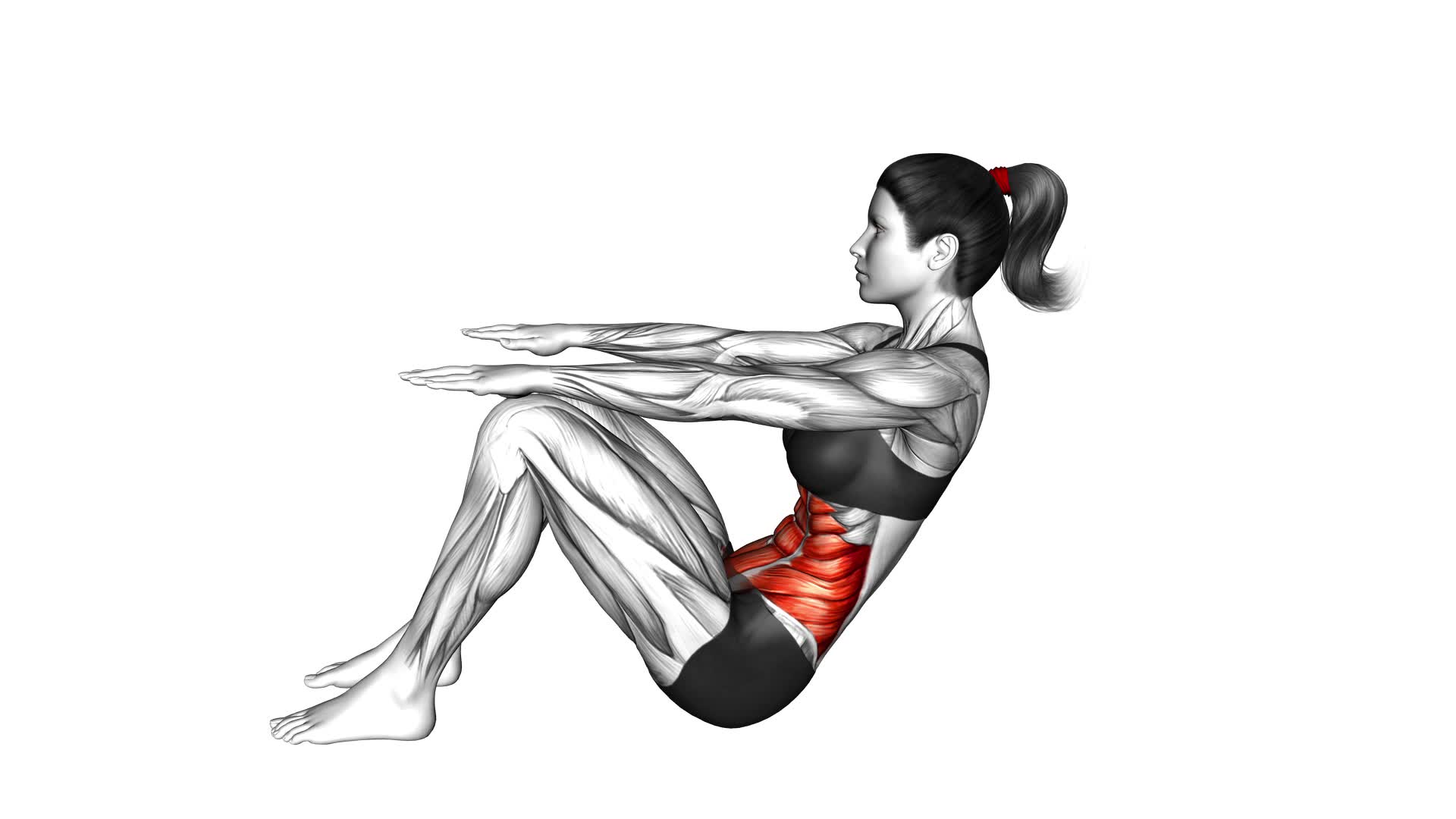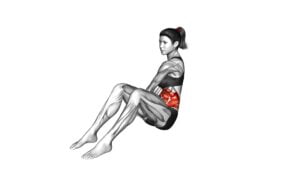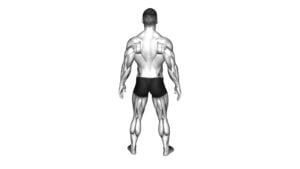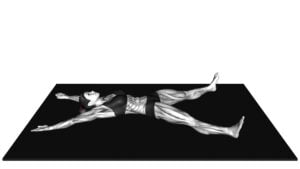V Hold (Beginner Level) (Female) – Video Exercise Guide & Tips

Are you a beginner looking to strengthen your core? Look no further than the V Hold!
Watch This Exercise Video
This video exercise guide and tips will show you the proper form and technique to get the most out of this move.
With modifications for beginners and helpful tips for progression, you'll be able to incorporate the V Hold into your workout routine with confidence.
Get ready to feel the burn and sculpt your abs like never before!
Key Takeaways
- V Hold improves core stability and engages the entire core.
- Maintaining proper form and technique is crucial to prevent injury and maximize the effectiveness of the exercise.
- Beginners can modify the exercise by bending the knees and starting with simplified variations.
- Progression techniques and advanced variations can be used to continuously challenge oneself and target different muscle groups.
Benefits of the V Hold
You will frequently experience various benefits when practicing the V Hold exercise. This exercise is highly effective in improving core stability and increasing abdominal strength. By engaging your core muscles and holding the V position, you challenge and strengthen the muscles in your abdomen, including the rectus abdominis, obliques, and transverse abdominis.
One of the key benefits of the V Hold exercise is the improvement in core stability. As you hold the V position, your core muscles work hard to maintain balance and control. This not only helps in everyday activities but also in sports and other physical activities that require stability and balance.
In addition to core stability, the V Hold exercise also helps in increasing abdominal strength. By consistently practicing this exercise, you target and strengthen your abdominal muscles, resulting in a stronger and more defined midsection.
Moreover, the V Hold exercise is a great way to engage your entire core, including the deep muscles that provide support and stability to your spine. This can help in improving posture and reducing the risk of back pain.
Proper Form and Technique
To maintain proper form and technique during the V Hold exercise, it's crucial to focus on engaging your core muscles and keeping your body in a balanced V position. One common mistake is allowing your lower back to sag or rounding your shoulders forward. To prevent this, imagine pulling your belly button towards your spine to engage your core and maintain a straight back. Another mistake is letting your legs drop too low or bending your knees. Aim to keep your legs straight and parallel to the ground, ensuring that your toes are pointed.
To progress in the V Hold exercise, you can start by holding the position for a shorter duration, such as 10 seconds, and gradually increase the time as your strength improves. Additionally, you can challenge yourself by lifting one leg off the ground while maintaining the V position. This will further engage your core and increase the difficulty of the exercise. Remember to breathe throughout the entire exercise, as it will help you maintain focus and stability.
By mastering the proper form and technique of the V Hold, you'll maximize the effectiveness of this exercise and achieve better results.
Now, let's explore some modifications for beginners to help you get started on your fitness journey.
Modifications for Beginners
Now that you've learned the proper form and technique for the V Hold exercise, let's talk about modifications for beginners.
Simplified exercise modifications can help you gradually build strength and avoid injury.
Remember to prioritize safety by listening to your body, taking breaks when needed, and gradually increasing the intensity as you progress.
Simplified Exercise Modifications
Simplified exercise modifications provide beginners with accessible options to adapt their workouts. These effective modifications and simplified exercise variations are designed to make it easier for beginners to get started and build strength gradually. If you're new to exercising, these modifications can help you perform the exercises correctly and safely, while still challenging your muscles.
For example, if you find it difficult to hold a V hold position, you can start by bending your knees and keeping your feet on the ground. As you gain strength and confidence, you can gradually straighten your legs and lift your feet off the ground. By starting with simplified variations, you can progress at your own pace and gradually work towards more advanced exercises.
Now that you have an understanding of simplified exercise modifications, let's move on to the next section where we'll discuss safety tips for beginners.
Safety Tips for Beginners
When starting out as a beginner, it's important to focus on safety and modifications that can help you perform exercises correctly and prevent injury. Here are some safety tips to keep in mind.
Firstly, make sure you have the right beginner workout equipment. Invest in a good pair of athletic shoes that provide support and cushioning to protect your feet and ankles. Additionally, consider using resistance bands or light dumbbells to add resistance to your workouts safely.
Secondly, always remember to warm up before starting your workout. This can include simple exercises like jumping jacks, arm circles, or a brisk walk to get your blood flowing and muscles warmed up. Warming up helps to loosen your joints and muscles, reducing the risk of injury.
Building Strength Gradually
Start with light weights and gradually increase the resistance to build strength as a beginner. Here are some tips to help you on your journey:
- Progressive Overload: This principle involves continuously increasing the demands on your muscles over time. Start with a weight that challenges you but allows you to maintain proper form. As you get stronger, gradually increase the weight to continue challenging your muscles.
- Muscle Activation: Focus on engaging the target muscles during each exercise. This will ensure that you're effectively working the intended muscle groups and maximizing your results.
- Listen to Your Body: Pay attention to how your body feels during and after each workout. If you experience excessive soreness or pain, it may be a sign that you need to reduce the weight or modify the exercise to avoid injury.
Common Mistakes to Avoid
To ensure proper form and maximize the effectiveness of your V Hold exercise, it's important to regularly assess and correct any common mistakes that you may be making. By avoiding these mistakes and improving your technique, you can achieve better results and reduce the risk of injury.
One common mistake to avoid is collapsing your lower back. When performing the V Hold, it's essential to maintain a straight spine and engage your core muscles. Avoid rounding your lower back or letting it sag towards the ground. Instead, imagine a straight line extending from your head to your tailbone.
Another mistake is incorrect hand placement. To achieve stability, make sure your hands are directly underneath your shoulders, with your fingers pointing forward. This will provide a solid base of support and prevent your wrists from straining.
Furthermore, avoid holding your breath during the exercise. Remember to breathe deeply and continuously throughout the V Hold. This will help oxygenate your muscles and keep you focused and energized.
Tips for Progression and Variations
To continue improving your technique and challenging yourself further, focus on progressing and incorporating variations into your V Hold exercise routine. Here are some tips to help you take your V Hold to the next level:
Progression Techniques:
- Increase the duration: Start by holding the V Hold for 10 seconds and gradually increase the time as you get stronger. Aim for 30 seconds or more.
- Add ankle weights: Once you can hold the position comfortably, add ankle weights to increase the resistance and intensify the exercise.
- Incorporate leg lifts: Lift one leg at a time while maintaining the V Hold position. This engages your core and challenges your balance even more.
Advanced Variations:
- Straddle V Hold: Instead of keeping your legs together, open them into a straddle position while maintaining the V Hold. This variation targets your inner thighs and adds an extra challenge.
- Russian Twist: While in the V Hold position, twist your torso from side to side, touching the ground with your fingertips. This adds a rotational element and works your obliques.
Weighted V Hold: Hold a dumbbell or medicine ball with both hands at chest level while performing the V Hold. This adds resistance and increases the difficulty of the exercise.
By incorporating these progression techniques and advanced variations, you'll continue to challenge your muscles and achieve greater strength and stability in your V Hold.
Now, let's explore how to incorporate the V Hold into your workout routine.
Incorporating the V Hold Into Your Workout Routine
To incorporate the V Hold into your workout routine, you can challenge yourself by gradually increasing the duration of the hold, adding ankle weights for added resistance, and incorporating leg lifts to engage your core and improve balance. By doing this, you won't only strengthen your core muscles but also enhance your overall fitness level.
When incorporating the V Hold into your core workouts, it's crucial to prioritize proper alignment. Maintaining a straight back and engaging your abdominal muscles will ensure that you're getting the most out of this exercise. Proper alignment also helps prevent injury and maximizes the effectiveness of the V Hold.
Start by holding the V position for a short duration, such as 10 seconds, and gradually increase the time as you get stronger. As you progress, you can add ankle weights to increase the resistance and further challenge your core muscles. Additionally, incorporating leg lifts into your V Hold will engage your core even more and improve your balance.
Frequently Asked Questions
How Long Should I Hold the V Hold Exercise?
To get the most out of the V hold exercise, it's important to hold it for the right amount of time. The duration can vary depending on your fitness level and goals. However, a good starting point is to aim for 30 seconds and gradually increase the time as you get stronger.
Holding the V hold engages your core muscles, improves balance, and strengthens your lower back. Don't forget to try different variations to challenge yourself and keep things interesting!
Can the V Hold Exercise Help With Strengthening the Core?
The V hold exercise is a great way to strengthen your core. By holding the V position, you engage your abdominal muscles, improving balance and stability.
There are also variations of the V hold exercise that you can try to challenge yourself even more. Incorporate these into your routine to see even better results.
Are There Any Specific Breathing Techniques to Follow While Performing the V Hold?
When performing the V hold, it's important to pay attention to your breathing. Take deep breaths in and out as you hold the position. This will help you engage your core and maintain stability.
Remember to exhale as you lift your legs off the ground and inhale as you lower them down.
If you find the exercise challenging, you can modify it by bending your knees or placing your hands on the ground for support.
Keep pushing yourself and you'll see progress!
Is It Necessary to Warm up Before Doing the V Hold Exercise?
It's important to warm up before doing any exercise, including the v hold. Warming up helps increase blood flow to your muscles, prepares your body for the workout, and reduces the risk of injury.
For beginners, there are modifications available to make the v hold easier. You can start by bending your knees or keeping your legs closer to the ground. Remember to listen to your body and gradually work your way up to the full v hold.
Keep pushing yourself and you'll see progress!
Can the V Hold Exercise Help With Improving Posture?
The V hold exercise is a great way to improve your posture while also strengthening your overall body. By engaging your core muscles and holding the V position, you're actively working on your abdominal and back muscles, which play a key role in maintaining good posture.
To get the most out of this exercise, remember to keep your back straight, shoulders relaxed, and engage your core throughout. With practice, you'll notice improvements in your posture and overall body strength.
Keep it up!
Conclusion
Incorporating the V Hold into your workout routine can provide numerous benefits. This exercise is known for strengthening your core, improving posture, and increasing overall body stability. By maintaining proper form and technique, beginners can gradually build their strength and endurance. It's important to avoid common mistakes like sagging or rounding your back, as this can lead to injury. Remember to progress at your own pace and listen to your body. With dedication and consistency, you can achieve your fitness goals and enjoy the rewarding results of the V Hold exercise. Keep pushing yourself and never underestimate the power of a strong core!

Author
Years ago, the spark of my life’s passion ignited in my mind the moment I stepped into the local gym for the first time. The inaugural bead of perspiration, the initial endeavor, the very first surge of endorphins, and a sense of pride that washed over me post-workout marked the beginning of my deep-seated interest in strength sports, fitness, and sports nutrition. This very curiosity blossomed rapidly into a profound fascination, propelling me to earn a Master’s degree in Physical Education from the Academy of Physical Education in Krakow, followed by a Sports Manager diploma from the Jagiellonian University. My journey of growth led me to gain more specialized qualifications, such as being a certified personal trainer with a focus on sports dietetics, a lifeguard, and an instructor for wellness and corrective gymnastics. Theoretical knowledge paired seamlessly with practical experience, reinforcing my belief that the transformation of individuals under my guidance was also a reflection of my personal growth. This belief holds true even today. Each day, I strive to push the boundaries and explore new realms. These realms gently elevate me to greater heights. The unique combination of passion for my field and the continuous quest for growth fuels my drive to break new ground.







